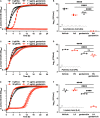Host Polyunsaturated Fatty Acids Potentiate Aminoglycoside Killing of Staphylococcus aureus
- PMID: 35377191
- PMCID: PMC9045252
- DOI: 10.1128/spectrum.02767-21
Host Polyunsaturated Fatty Acids Potentiate Aminoglycoside Killing of Staphylococcus aureus
Abstract
Aminoglycoside antibiotics rely on the proton motive force to enter the bacterial cell, and facultative anaerobes like Staphylococcus aureus can shift energy generation from respiration to fermentation, becoming tolerant of aminoglycosides. Following this metabolic shift, high concentrations of aminoglycosides are required to eradicate S. aureus infections, which endangers the host due to the toxicity of aminoglycosides. Membrane-disrupting molecules prevent aminoglycoside tolerance in S. aureus by facilitating passive entry of the drug through the membrane. Polyunsaturated fatty acids (PUFAs) increase membrane permeability when incorporated into S. aureus. Here, we report that the abundant host-derived PUFA arachidonic acid increases the susceptibility of S. aureus to aminoglycosides, decreasing the aminoglycoside concentration needed to kill S. aureus. We demonstrate that PUFAs and aminoglycosides synergize to kill multiple strains of S. aureus, including both methicillin-resistant and -susceptible S. aureus. We also present data showing that PUFAs and aminoglycosides effectively kill S. aureus small colony variants, strains that are particularly recalcitrant to killing by many antibiotics. We conclude that cotreatment with PUFAs, which are molecules with low host toxicity, and aminoglycosides decreases the aminoglycoside concentration necessary to kill S. aureus, lowering the toxic side effects to the host associated with prolonged aminoglycoside exposure. IMPORTANCE Staphylococcus aureus infects every niche of the human host, and these infections are the leading cause of Gram-positive sepsis. Aminoglycoside antibiotics are inexpensive, stable, and effective against many bacterial infections. However, S. aureus can shift its metabolism to become tolerant of aminoglycosides, requiring increased concentrations and/or longer courses of treatment, which can cause severe host toxicity. Here, we report that polyunsaturated fatty acids (PUFAs), which have low host toxicity, disrupt the S. aureus membrane, making the pathogen susceptible to aminoglycosides. Additionally, cotreatment with aminoglycosides is effective at killing S. aureus small colony variants, strains that are difficult to treat with antibiotics. Taken together, the data presented herein show the promise of PUFA cotreatment to increase the efficacy of aminoglycosides against S. aureus infections and decrease the risk to the human host of antibiotic-induced toxicity.
Keywords: MRSA; PUFA; Staphylococcus aureus; aminoglycoside; antibiotic tolerance; arachidonic acid; gentamicin; linoleic acid; persister; polyunsaturated fatty acid; small colony variant.
Conflict of interest statement
The authors declare no conflict of interest.
Figures


Similar articles
-
Arachidonic Acid Kills Staphylococcus aureus through a Lipid Peroxidation Mechanism.mBio. 2019 Oct 1;10(5):e01333-19. doi: 10.1128/mBio.01333-19. mBio. 2019. PMID: 31575763 Free PMC article.
-
Chemical Induction of Aminoglycoside Uptake Overcomes Antibiotic Tolerance and Resistance in Staphylococcus aureus.Cell Chem Biol. 2019 Oct 17;26(10):1355-1364.e4. doi: 10.1016/j.chembiol.2019.07.009. Epub 2019 Aug 8. Cell Chem Biol. 2019. PMID: 31402316 Free PMC article.
-
5-Methylindole Potentiates Aminoglycoside Against Gram-Positive Bacteria Including Staphylococcus aureus Persisters Under Hypoionic Conditions.Front Cell Infect Microbiol. 2020 Feb 28;10:84. doi: 10.3389/fcimb.2020.00084. eCollection 2020. Front Cell Infect Microbiol. 2020. PMID: 32185144 Free PMC article.
-
Aminoglycosides with Anti-MRSA Activity: A Concise Review.Curr Top Med Chem. 2021;21(27):2483-2499. doi: 10.2174/1568026621666211004093647. Curr Top Med Chem. 2021. PMID: 34607544 Review.
-
Recalcitrant Staphylococcus aureus Infections: Obstacles and Solutions.Infect Immun. 2021 Mar 17;89(4):e00694-20. doi: 10.1128/IAI.00694-20. Print 2021 Mar 17. Infect Immun. 2021. PMID: 33526569 Free PMC article. Review.
Cited by
-
Nitrate Reductase NarGHJI Modulates Virulence via Regulation of agr Expression in Methicillin-Resistant Staphylococcus aureus Strain USA300 LAC.Microbiol Spectr. 2023 Jun 15;11(3):e0359622. doi: 10.1128/spectrum.03596-22. Epub 2023 May 18. Microbiol Spectr. 2023. PMID: 37199609 Free PMC article.
-
Enhanced Anti-Bacterial Activity of Arachidonic Acid against the Cariogenic Bacterium Streptococcus mutans in Combination with Triclosan and Fluoride.Antibiotics (Basel). 2024 Jun 10;13(6):540. doi: 10.3390/antibiotics13060540. Antibiotics (Basel). 2024. PMID: 38927206 Free PMC article.
-
Overcoming biological barriers to improve treatment of a Staphylococcus aureus wound infection.Cell Chem Biol. 2023 May 18;30(5):513-526.e5. doi: 10.1016/j.chembiol.2023.04.009. Epub 2023 May 5. Cell Chem Biol. 2023. PMID: 37148883 Free PMC article.
-
Antibiotic-induced accumulation of lipid II synergizes with antimicrobial fatty acids to eradicate bacterial populations.Elife. 2023 Mar 6;12:e80246. doi: 10.7554/eLife.80246. Elife. 2023. PMID: 36876902 Free PMC article.
-
Targeting the Holy Triangle of Quorum Sensing, Biofilm Formation, and Antibiotic Resistance in Pathogenic Bacteria.Microorganisms. 2022 Jun 16;10(6):1239. doi: 10.3390/microorganisms10061239. Microorganisms. 2022. PMID: 35744757 Free PMC article. Review.
References
Publication types
MeSH terms
Substances
Grants and funding
LinkOut - more resources
Full Text Sources
Medical

